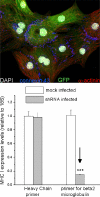Immunological barriers to stem-cell based cardiac repair
- PMID: 21086071
- PMCID: PMC3073044
- DOI: 10.1007/s12015-010-9202-x
Immunological barriers to stem-cell based cardiac repair
Abstract
Repair of damaged myocardium with pluripotent stem cell derived cardiomyocytes is becoming increasingly more feasible. Developments in stem cell research emphasize the need to address the foreseeable problem of immune rejection following transplantation. Pluripotent stem cell (PSC) derived cardiomyocytes have unique immune characteristics, some of which are not advantageous for transplantation. Here we review the possible mechanisms of PSC-derived cardiomyocytes rejection, summarize the current knowledge pertaining to immunogenicity of such cells and describe the existing controversies. Myocardial graft rejection can be reduced by modifying PSCs prior to their differentiation into cardiomyocytes. Overall, this approach facilitates the development of universal donor stem cells suitable for the regeneration of many different tissue types.
Figures



Similar articles
-
Human pluripotent stem cells: Prospects and challenges as a source of cardiomyocytes for in vitro modeling and cell-based cardiac repair.Adv Drug Deliv Rev. 2016 Jan 15;96:3-17. doi: 10.1016/j.addr.2015.05.004. Epub 2015 May 14. Adv Drug Deliv Rev. 2016. PMID: 25980938 Free PMC article. Review.
-
Recent Progress Using Pluripotent Stem Cells for Cardiac Regenerative Therapy.Circ J. 2017 Jun 23;81(7):929-935. doi: 10.1253/circj.CJ-17-0400. Epub 2017 Jun 10. Circ J. 2017. PMID: 28603177 Review.
-
Embryonic template-based generation and purification of pluripotent stem cell-derived cardiomyocytes for heart repair.J Cardiovasc Transl Res. 2012 Oct;5(5):566-80. doi: 10.1007/s12265-012-9391-6. Epub 2012 Jul 18. J Cardiovasc Transl Res. 2012. PMID: 22806916 Review.
-
Cardiac applications for human pluripotent stem cells.Curr Pharm Des. 2009;15(24):2791-806. doi: 10.2174/138161209788923804. Curr Pharm Des. 2009. PMID: 19689350 Free PMC article. Review.
-
Progenitor cell therapy for heart disease.Exp Cell Res. 2009 Nov 1;315(18):3077-85. doi: 10.1016/j.yexcr.2009.09.006. Epub 2009 Sep 10. Exp Cell Res. 2009. PMID: 19747911 Review.
Cited by
-
Detection of Stem Cell Transplant Rejection with Ferumoxytol MR Imaging: Correlation of MR Imaging Findings with Those at Intravital Microscopy.Radiology. 2017 Aug;284(2):495-507. doi: 10.1148/radiol.2017161139. Epub 2017 Jan 27. Radiology. 2017. PMID: 28128708 Free PMC article.
-
Downregulation of beta-microglobulin to diminish T-lymphocyte lysis of non-syngeneic cell sources of engineered heart tissue constructs.Biomed Mater. 2015 Mar 16;10(3):034101. doi: 10.1088/1748-6041/10/3/034101. Biomed Mater. 2015. PMID: 25775354 Free PMC article.
-
Nanotechnology in interventional cardiology: A state-of-the-art review.Int J Cardiol Heart Vasc. 2022 Nov 18;43:101149. doi: 10.1016/j.ijcha.2022.101149. eCollection 2022 Dec. Int J Cardiol Heart Vasc. 2022. PMID: 36425567 Free PMC article. Review.
-
HLA Class I Depleted hESC as a Source of Hypoimmunogenic Cells for Tissue Engineering Applications.Tissue Eng Part A. 2015 Oct;21(19-20):2559-71. doi: 10.1089/ten.TEA.2015.0105. Epub 2015 Sep 10. Tissue Eng Part A. 2015. PMID: 26218149 Free PMC article.
-
Teratocarcinomas Arising from Allogeneic Induced Pluripotent Stem Cell-Derived Cardiac Tissue Constructs Provoked Host Immune Rejection in Mice.Sci Rep. 2016 Jan 14;6:19464. doi: 10.1038/srep19464. Sci Rep. 2016. PMID: 26763872 Free PMC article.
References
-
- Zak R. Development and proliferative capacity of cardiac muscle cells. Circulation Research. 1974;35(suppl II):17–26. - PubMed
-
- Pasumarthi KB, Field LJ. Cardiomyocyte cell cycle regulation. Circulation Research. 2002;90:1044–1054. - PubMed
-
- Hodgson DM, Behfar A, Zingman LV, et al. Stable benefit of embryonic stem cell therapy in myocardial infarction. American Journal of Physiology. Heart and Circulatory Physiology. 2004;287:H471–H479. - PubMed
-
- Caspi O, Huber I, Kehat I, et al. Transplantation of human embryonic stem cell-derived cardiomyocytes improves myocardial performance in infarcted rat hearts. Journal of the American College of Cardiology. 2007;50:1884–1893. - PubMed
Publication types
MeSH terms
Substances
Grants and funding
LinkOut - more resources
Full Text Sources
Other Literature Sources
Medical

